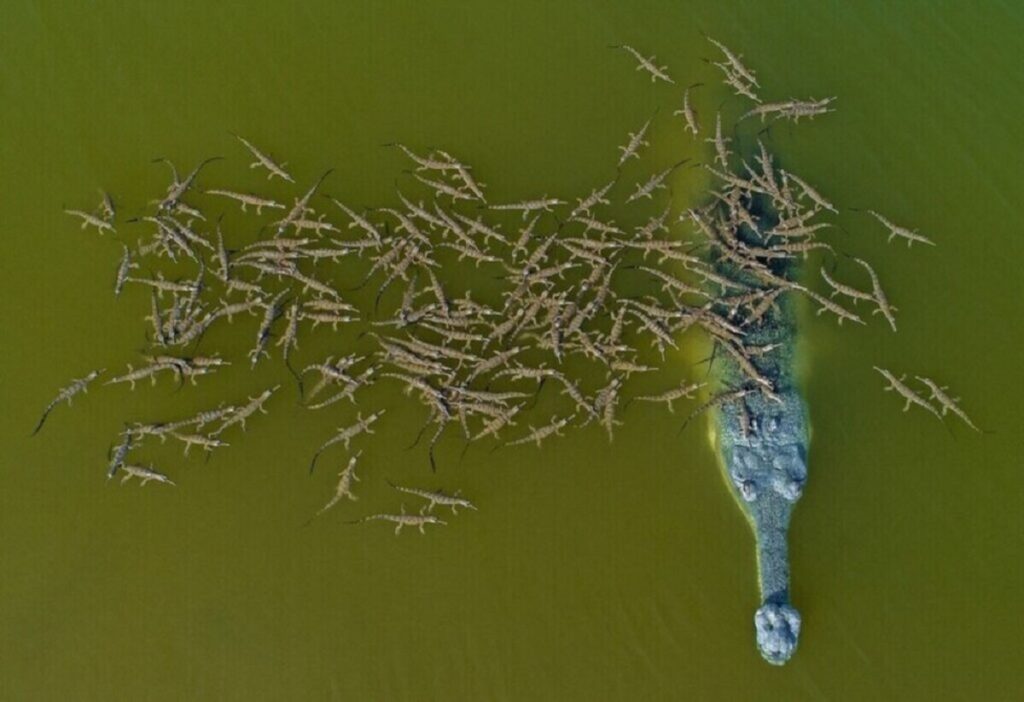Deep within a wildlife sanctuary lies a breathtaking image that could easily be mistaken for a scene from a fantasy novel. Yet, I assure you, this moment captures the raw beauty of reality: a colossal crocodile gracefully gliding through the revered Ganges River, adorned not with a solitary companion, but with a hundred tiny baby crocodiles nestled on its back. This astonishing photograph not only portrays the marvels of nature but also sheds light on the pressing conservation challenges faced by this endangered species.
An Extraordinary Encounter in a Sacred River
The Ganges River, a sacred and vital habitat, nurtures a multitude of unique species, including the critically endangered gharial crocodile. Photographer Dhritiman Mukherjee dedicated several weeks at a wildlife sanctuary, attentively observing the river’s intricate ecosystems. His patience was rewarded with a spectacular capture of a male gharial—likely a guardian of the young—carrying his hatchlings in a manner seldom witnessed in the animal kingdom.
Unlike their crocodilian cousins, gharials possess elongated snouts and sharp teeth, which preclude the common method of transporting their young in their mouths. Instead, these remarkable reptiles have evolved a protective behavior, enabling their offspring to ride safely on their backs, shielded from strong river currents. This fascinating parental strategy highlights their adaptability in ensuring the survival of their young amidst harsh natural challenges.
The Role of Fathers in Gharial Society
While it may seem surprising to witness a massive crocodile ferrying its young on its back, this behaviour is critical to their survival. With only about 650 adult gharials remaining in the wild, ensuring the survival of each hatchling is paramount. Patrick Campbell, the senior reptile curator at the Natural History Museum, notes that these magnificent creatures, which can reach lengths of up to four meters and weigh nearly 900 kilograms, are confronting immense threats from habitat degradation and human encroachment.
The Chambal River, home to the largest population of gharials, hosts approximately 500 of these reptiles, each battling to survive in increasingly fragmented habitats. Each successful breeding season brings a flicker of hope for conservationists tirelessly working to safeguard the species.
Seizing the Spirit of the River

Mukherjee’s stunning photograph captures not merely a fleeting moment in nature, but encapsulates the very essence of life, resilience, and family dynamics within the animal kingdom. His patience and considerate approach while photographing these creatures testify to his commitment to the craft and his profound connection to the natural world. Maintaining a respectful distance, he allows his camera to bring us closer to these majestic beings without disrupting their natural behaviours.
This remarkable image has not only been shortlisted for the esteemed Wildlife Photographer of the Year award but also clinched victory in a competition held by the Natural History Museum, emerging as a standout among thousands of entries. As someone who values the power of storytelling, this image resonates deeply with me, serving as a poignant reminder of the fragile equilibrium in nature and the unique ways in which creatures like the gharial adapt to their environments.
In communities like Austin, where conservation efforts are deeply intertwined, narratives such as these become even more impactful. They serve as a powerful call to action, urging us to recognize our shared responsibility in safeguarding our planet and its remarkable inhabitants.
A Testament to Nature’s Endurance
Mukherjee’s gripping photograph stands as a tribute to nature’s resilience and the spirit of fatherhood within the wild. It prompts us to pause, contemplate, and appreciate the intricate relationships that permeate our world, often ignored amid the daily grind. In moments like these, we find ourselves not only captivated but also inspired by the profound connections that bind all living beings on Earth.







